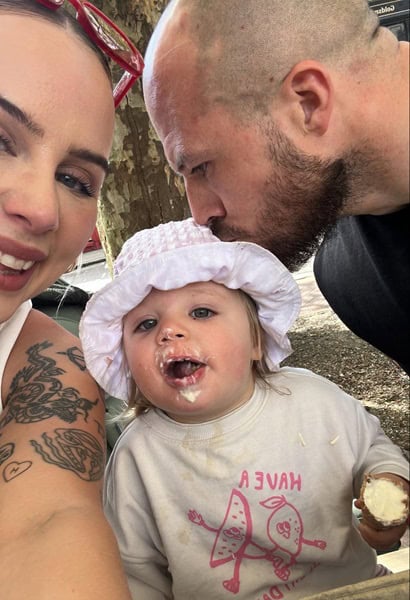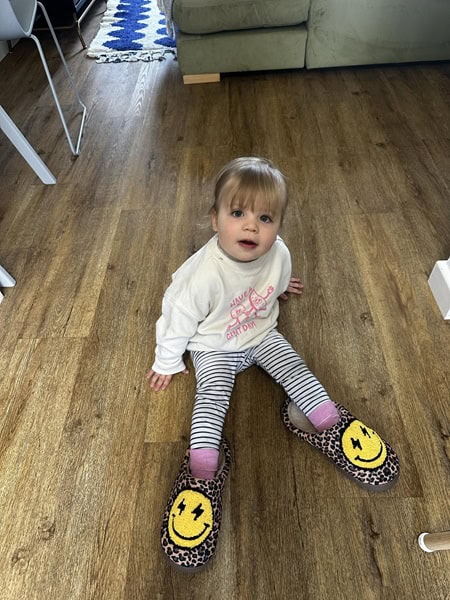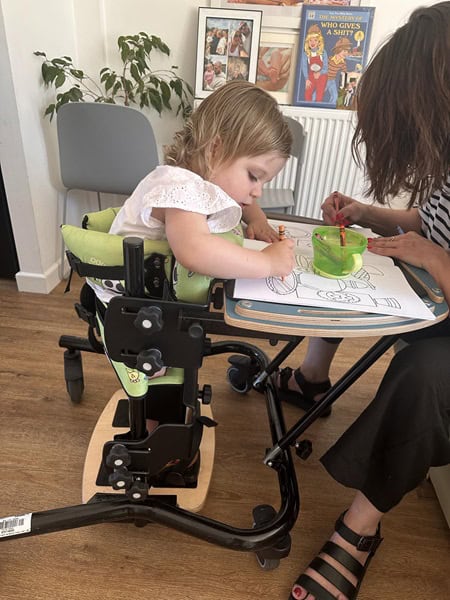
Harper Dunsford, who will be two years old on July 30, is a chatty and bright little girl who can recite her numbers to 20, sing the entirety of Twinkle Twinkle Little Star and is completely obsessed with fire engines!
But Harper and her parents Mia Clark and Clayton Dunsford, from Ramsgate, face huge challenges after a diagnosis last month that the little one has type 2 spinal muscular atrophy – a genetic neurological muscular disease classified as a motor neurone disease.
The condition means the body doesn’t make enough SMN protein, so motor neurons shrink and die. As a result, the brain can’t control voluntary movements, especially motion in the head, neck, chest and legs, and there is muscle weakness that limits physical ability.

Mia, 28, said: “We had known for a long time that something was wrong and for over a year had been trying to get answers for Harper.
“I knew something wasn’t right with Harp’s mobility, it was always a struggle for her and she moved a lot differently to other children. But because she was so bright and chatty, everybody thought that maybe she focused on her chatting more than she did moving around.
“I originally took her to the health visitor in August 2023 with concerns about how her feet turned in and she had arm and hand tremors. They referred Harper to the GP thinking she had missed hip dysplasia. The doctor gave her an average check over, but definitely not in depth, and said she would do a physio referral but she didn’t see any immediate concerns.
“Six weeks went by and I hadn’t heard anything from the doctors, so I went into the surgery and they had informed me the doctor had forgotten to do the referral.”

At that point Mia, previously a photographer at Polydor records, and Clayton, who runs Ramsgate Tyre Centre, decided to go private and see a physio thought the issue was physical developmental delays.
Mia said: “Come January 2024, our NHS physio started and I really have to commend the NHS physio as they have gone over and beyond for her, every little need she needs, they’ve done it. But they were just as clueless as we were.
“Harper has always had tremors from the age of six months in her hands and arms. She shakes quite often. They suggested we go to the doctors about Harper’s tremors, so we did, and then that took us to the beginning of April 2024 when we finally got a paediatrician appointment with the amazing Dr Maha Farah, who really took this seriously and referred Harper for a full blood work, genetics bloods and a referral to neurology at Evelina Children’s Hospital.

“In the meantime between April – June Harper lost most of her mobility, she was unable to stand, cruise and her crawling became more limited. With the concerns of her regression, they fast-tracked the genetic bloods of SMN1 protein -looking into Spinal Muscular Atrophy. “That took two weeks and on Sunday 23rd June we got the unfortunate news she had type 2 Spinal Muscular Atrophy.
“This diagnosis has absolutely turned my world upside down. You just don’t expect when you have children for any of these things to happen. You should be prepared for anything with children but a motor neurone disease? It’s just beyond anything we could have imagined when your child doesn’t walk.”

SMA is a progressive condition and children and babies with the disease typically lose rapid motor control and end up with progressive scoliosis, intercostal muscle weakness and restrictive lung disease. The condition can be life-limiting without treatment.
There is no cure but in 2016 a “miracle drug” called Spinraza was made available after clinical trials and extensive testing.
The drug, which is one of the most expensive for the NHS, was accepted for use within NHS Scotland in 2018 and this was widened in 2019 so it’s available to eligible people with SMA through a Managed Access Agreement (which includes continued collection of data) in England.
Thankfully Harper has been accepted as eligible for the treatment and started last week.
The drug, administered by a lumber puncture, is putting the SMN1 protein back into Harper’s body to slow the progression of the disease and help her regain motor control. With extensive physio, Harper could regain some of the skills she has lost and live a long and happy life.
Harper will have three more doses in the next 60 days, and then every four months for the rest of her life.

Mia said: “Nobody prepares you for a near two year old having a lumber puncture. I am so proud and in awe of my daughter and how she has handled everything like a champ. She really is my inspiration.
“Harper will still require wheelchair use, aids and aggressive therapy but we will not give up on getting her to reach her full potential.”
Despite the disease Mia says Harper is “a happy little girl” who enjoys her sessions at Under 1 Roof nursery, loves singing, is intellectually gifted and is a “real little character.”
Mia added: ““Under 1 Roof has been so supportive, they have gone above and beyond.
“Harper has handled everything like a champ. I really am so proud of her. She chats and plays with everyone and is so funny.
“Despite everything Harper is facing, she is amazing. She is so bright and so smart, she can count to 20, knows all her colours and she blows me away.”

Mia, who as Harper’s full-time carer can no longer work, and Clayton, 32, are now raising money through a gofundme to help pay for things to adapt to and improve Harper’s life such as home adaptations, mobility aids, a specialist wheelchair, equipment and for help with travel to hospital – they will need to visit Evelina some 15 times in the next two months.
Find the fundraiser for Harper by clicking here
Ramsgate Rumble 2 for Harper
A Ramsgate Rumble boxing tournament event on Saturday 14th September will be raising funds for Harper.
The event has been organised by Connor Gorham of CG Boxing and Fitness Club. It will be held at Ramsgate’s Granville Theatre, doors open 2pm, first fight 4pm.
Connor said: “ I feel it’s a great opportunity to raise funds for young Harper who has been diagnosed with a rare genetic neurological muscular disease SMA Type 2. This will contribute towards any equipment or treatment she needs towards a better quality of life. “We also aim to raise awareness for this condition for anyone who could be in similar circumstances hoping they can get the help they need.”
The event will include a raffle and auction. Tickets are £40. Buy here
Spinal muscular atrophy
Spinal Muscular Atrophy is a rare, neuromuscular condition. It causes progressive muscle wasting and weakness. It may affect crawling and walking ability, arm, hand, head and neck movement, breathing and swallowing.
There are four types of SMA with 1 and 2 being most severe.
It is a genetic condition caused by a change in a gene called ‘survival motor neuron 1’ (SMN1). Everybody has two copies of the SMN1 gene – one inherited from each parent. People with SMA have a gene change in both copies of the SMN1 gene.
All types of SMA affect the nerve cells called lower motor neurons. These are found within the spinal cord and transmit signals to muscles. These nerve cells carry electrical signals from the brain to activate the muscles used for movement such as crawling and walking. These signals control movement of arms, hands, head and neck as well as breathing and swallowing. For these nerve cells to be healthy, our Survival Motor Neuron 1 genes (SMN1 genes) must produce enough Survival Motor Neuron (SMN) protein.
People with SMA are unable to produce enough SMN protein to have healthy lower motor neurons. This means these specialist nerve cells in the spinal cord deteriorate. This restricts the delivery of signals from the brain to their muscles, making movement difficult. The muscles then waste due to lack of use – this is known as muscular atrophy.
Find information and support at: https://www.musculardystrophyuk.org/

